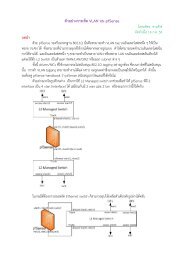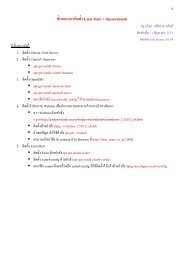Introduction to SELinux
Introduction to SELinux
Introduction to SELinux
You also want an ePaper? Increase the reach of your titles
YUMPU automatically turns print PDFs into web optimized ePapers that Google loves.
<strong>Introduction</strong> <strong>to</strong> <strong>SELinux</strong><br />
Henrik Rydmark<br />
May 2005<br />
Red Hat
Red Hat Security Activities<br />
• Enterprise Linux model<br />
• backport fixes in<strong>to</strong> existing code tree<br />
• eliminate Open Source Software challenges<br />
• Red Hat Network<br />
• efficient deployment of relevant errata<br />
• Red Hat Security Response Team<br />
• single point of contact<br />
• coordinate fix testing with partners<br />
• track known problems and solutions in public database<br />
• Security certifications: EAL3+, COE<br />
• Develop security features<br />
• configuration / hardening <strong>to</strong>ols<br />
• Exec Shield<br />
• <strong>SELinux</strong>
Enterprise Linux as a Model<br />
• Red Hat Enterprise Linux addresses a number of problems:<br />
• Architectural stability – makes OSS predictable<br />
• Defined platform, certification, compatibility<br />
• „Slowing down” the release cycle – only every 12 – 18 months<br />
• Long term support and maintenance (7 years) for each version<br />
with backports of security fixes<br />
• Provides a predictable platform for ISVs, OSS projects and<br />
the user<br />
• Resolves the version and certification conflicts<br />
• Provides long term security<br />
Red Hat Enterprise Linux model<br />
eliminates hindering problem
Red Hat Network<br />
• Red Hat Network solves the patch problem<br />
by providing:<br />
• Efficient centralized software<br />
deployment based on RPM<br />
• Especially: Errata delivery directly from<br />
Red Hat<br />
• Centralized configuration management<br />
• Transparent and credible – clients<br />
GPLed<br />
• Notification and relevance verification<br />
• Makes Open Source deployable –<br />
removing the „Guru fac<strong>to</strong>r“<br />
• Makes actions reproduceable<br />
• Hosted and in-house solutions<br />
(Satellite) available<br />
With RHN applying fixes is as easy as possible
Existing OS Security Features<br />
• Security features in RHEL 3 and RHEL 4<br />
• Standard Linux features (multi user OS, IPTables, etc.)<br />
• Signed Packages (RPM)<br />
• POSIX ACLs<br />
• Exec-Shield<br />
• stack protection for all CPU types (using NX technology if<br />
available)<br />
• Stack, heap and shared library position randomization<br />
• Position Independent Executables (PIE)<br />
• ELF Data Hardening<br />
• COE and EAL certification
Is this enough?<br />
• Activites and the traditional security model<br />
solves a lot of the problems…<br />
• But what, if an attack is successful?<br />
• What about misconfiguration?<br />
• What about treacherous users?<br />
Objective: Reduce the remaining risk by limiting the<br />
potential damage caused by the failure of these security<br />
mechanisms<br />
A Manda<strong>to</strong>ry Access Control<br />
system is needed
Current Linux Security Model<br />
• Referred <strong>to</strong> as Discretionary Access Control<br />
• Traditional OS/Unix mechanism<br />
• Programs runs with the permission of the user executing it<br />
• File permissions and ACL<br />
• setuid/setgid binaries: mount, passwd, ping<br />
• chroot – a restricted filesystem namespace<br />
• Root is all powerful<br />
• Too coarse grained<br />
• root vs non-root gives boolean security model for many cases<br />
• Users & programs have complete control<br />
• The level of system security is left <strong>to</strong> the discretion of the<br />
applications running on it.<br />
Virtually any compromise or misconfiguration of the<br />
above can easily lead <strong>to</strong> <strong>to</strong>tal system compromise
Manda<strong>to</strong>ry Access Control<br />
• Defined by three major properties:<br />
• Centralized defined security policy.<br />
• Policy set by administra<strong>to</strong>r and enforced by the system<br />
• Policy cannot be overridden either accidentally or deliberately by malicious<br />
software and users<br />
• Control over all subjects (processes) and objects.<br />
• May be applied <strong>to</strong> object not protected by normal access controls, such as<br />
network sockets and processes.<br />
• Prevents information leaks or privilege escalation even from accidental<br />
misconfiguration<br />
• Decisions based on all security-relevant information.<br />
• Security administra<strong>to</strong>r can ensure two domains never interact,<br />
even if they're both compromised<br />
• For example, the web server and your raw database<br />
• Allows protection against untrusted code<br />
• Follows the principle of least privileges
What is <strong>SELinux</strong>?<br />
• A system for Manda<strong>to</strong>ry Access Control (MAC) based on the Linux<br />
Security Modules (LSM) framework, integrated in the mainstream 2.6<br />
kernel<br />
• Building on 10 years of NSA’s OS security research<br />
• Application of NSA’s Flask security architecture<br />
• Cleanly separates policy from enforcement using well-defined policy<br />
interfaces<br />
• Allows users <strong>to</strong> express policies naturally and supports changes<br />
• Fine-grained controls over kernel services<br />
• Transparent <strong>to</strong> applications and users<br />
• <strong>SELinux</strong> model is independent of normal Linux model, checked after<br />
normal Linux checks<br />
• Policies define what <strong>SELinux</strong> does<br />
• Implements MAC via a combination of Type Enforcement and Role-<br />
Based Access Control
<strong>SELinux</strong> – How it works<br />
Process Pa<br />
SC<br />
<strong>SELinux</strong><br />
<strong>SELinux</strong><br />
Kernel<br />
Kernel<br />
SC<br />
File Fa<br />
Process Pb<br />
SC<br />
User Ua SC<br />
Security<br />
Policy<br />
SC<br />
SC<br />
File Fb<br />
Device Da<br />
User Ub<br />
SC<br />
SC<br />
Device Db<br />
Subject Requests<br />
Action on an<br />
Object<br />
Security<br />
Enforcement<br />
Module:<br />
Permits or denies<br />
accesses <strong>to</strong><br />
all objects<br />
Permission<br />
Granted <strong>to</strong><br />
Object
<strong>SELinux</strong> Type Persistence<br />
• Type assignments on regular files s<strong>to</strong>red in xattr<br />
• check with ls -Z<br />
• set with chcon<br />
• apply policy assignments with res<strong>to</strong>reson, setfiles or fixfiles<br />
• after policy change au<strong>to</strong>matic relabeling initiated<br />
• $MNTPOINT/.au<strong>to</strong>relabel res<strong>to</strong>res policy assignments on every boot<br />
• Filesystems without xattr support<br />
• vfat, nfs, smbfs, tmpfs etc.<br />
• set context for all files with mount option -o context=....<br />
• set context for filesystem types in genfs_contexts<br />
• set context transition in policy of your program<br />
• non-file resources<br />
• network ports, fs mount, kernel module load etc.<br />
• type assignment defined in policy
<strong>SELinux</strong> Policy<br />
• Defines whole security model<br />
• Type declarations of system resources<br />
• Class declarations with their operations<br />
• Role declarations<br />
• Domain transitions<br />
• Access vec<strong>to</strong>rs: operations on types as granted operations on classes<br />
• Written at a high level with M4 macros<br />
• Compiled in<strong>to</strong> a binary form that is unders<strong>to</strong>od by the kernel<br />
• Loaded by /sbin/init at the start of the boot process before any<br />
other programs are executed<br />
• A modified policy can be loaded at any time by the administra<strong>to</strong>r<br />
Everything not explicity allow is denied
Type Enforcement (TE)<br />
• Seven types of declarations; attribute, type, typealias, boolean,<br />
transition, access vec<strong>to</strong>r and conditional<br />
• Associates each program with a domain and each nonprocess with<br />
a type.<br />
type httpd_config_t, file_type, sysadmfile;<br />
• Permissions are encoded as access vec<strong>to</strong>rs, which specify the<br />
operations that a domain is authorized <strong>to</strong> perform on objects of a<br />
giving type, such as files.<br />
allow passwd_t shadow_t:file { read write };<br />
Result<br />
No matching policy rule<br />
allow<br />
auditallow<br />
dontaudit<br />
Access permitted<br />
No<br />
Yes<br />
No, unless allow<br />
No<br />
Result logged<br />
No<br />
No, unless auditallow<br />
Yes<br />
No
Role-Based Access Control<br />
(RBAC)<br />
• Defining rules for every user <strong>to</strong> use every program <strong>to</strong> access<br />
every object would result in an enormous set of rules.<br />
• Need for a second security model. Working alongside Type<br />
Enforcement<br />
• Under RBAC, administra<strong>to</strong>rs define roles and allow certain<br />
users access <strong>to</strong> those roles.<br />
• Specifies roles that are authorized for each user<br />
user root roles { user_r sysadm_r system_r };<br />
• Defines allowed transition between roles<br />
allow system_r sysadm_r;<br />
• Specifies domains that can be entered by each role<br />
role system_r types httpd_t;
Example – snort.fc<br />
# SNORT<br />
/usr/(s)?bin/snort --<br />
/etc/snort(/.*)?<br />
/var/log/snort(/.*)?<br />
system_u:object_r:snort_exec_t<br />
system_u:object_r:snort_etc_t<br />
system_u:object_r:snort_log_t
Example – snort.te<br />
#DESC Snort - Network sniffer<br />
#<br />
# Author: Shaun Savage <br />
# Modified by Russell Coker <br />
# X-Debian-Packages: snort-common<br />
#<br />
daemon_domain(snort)<br />
logdir_domain(snort)<br />
allow snort_t snort_log_t:dir create;<br />
can_network_server(snort_t)<br />
type snort_etc_t, file_type, sysadmfile;<br />
# Create temporary files.<br />
tmp_domain(snort)<br />
allow snort_t snort_log_t:dir create;<br />
can_network_server(snort_t)<br />
type snort_etc_t, file_type, sysadmfile;<br />
# use iptable netlink<br />
allow snort_t self:netlink_route_socket { bind create<br />
getattr read write };<br />
allow snort_t self:packet_socket create_socket_perms;<br />
allow snort_t self:capability { setgid setuid net_admin<br />
net_raw dac_override };<br />
r_dir_file(snort_t, snort_etc_t)<br />
allow snort_t etc_t:file { getattr read };<br />
allow snort_t etc_t:lnk_file read;<br />
allow snort_t self:unix_dgram_socket create_socket_perms;<br />
allow snort_t self:unix_stream_socket<br />
create_socket_perms;<br />
# for start script<br />
allow initrc_t snort_etc_t:file read;<br />
dontaudit snort_t { etc_runtime_t proc_t }:file read;<br />
allow snort_t etc_t:file { getattr read };
Permissive versus Enforcing<br />
• <strong>SELinux</strong> can run in 3 modes:<br />
• Permissive mode<br />
• Policy loaded<br />
• Auditing enabled<br />
• No denial, only logging<br />
• Useful for policy writing and troubleshooting<br />
• Enforcing mode<br />
• Policy loaded<br />
• Auditing enabled<br />
• Action denial or grant depending on policy<br />
• Disabled<br />
• Policy not loaded<br />
• No auditing<br />
Only enforcing mode provides more security
<strong>SELinux</strong> Implementation in RHEL<br />
• Integrated in<strong>to</strong> standard RHEL versions – full ISV support<br />
• Not only the code but actual policies:<br />
• Targeted policy in core product secures key network-facing services<br />
with minimal system impact<br />
• Support for strict and cus<strong>to</strong>m policies through Red Hat Global<br />
Professional Services<br />
• OS integration<br />
• Integrated in<strong>to</strong> system boot<br />
• Policy information gathering, analyse, compiling <strong>to</strong>ols<br />
• Changed programs for role support: su, login, pam etc.<br />
• Changed programs for type & domain support: ls, find, id (-Z)<br />
• Simplified policy management<br />
• system-config-securitylevel<br />
• set booleans instead of policy writing<br />
• Documentation & Support
Strict Policy vs Targeted Policy<br />
Strict policy<br />
• All processes, including user logins,<br />
run in restricted domain; again, any<br />
interaction not explicitly permitted is<br />
denied<br />
• Restricting system heavily - not<br />
shipped with RHEL<br />
• Supported through Red Hat GPS<br />
• Source +200k lines. Binary ~8M<br />
Targeted policy<br />
• Only certain key system daemons<br />
confined by <strong>SELinux</strong> denial rules;<br />
dhcpd, httpd, named, nscd, ntpd,<br />
portmap, snmpd, squid, syslogd,<br />
mtas, mailman, mysql, postgresql,<br />
winbind, ypbind<br />
• Everything else runs as unconfined_t,<br />
a domain which is granted essentially<br />
every <strong>SELinux</strong> permission<br />
• Goal is <strong>to</strong> restrict above daemons,<br />
not protect them against the rest of<br />
the system<br />
• Use of policy booleans allows<br />
dynamic reconfiguration<br />
• Disable protection for squid, disable<br />
httpd's ability <strong>to</strong> read user home<br />
direc<strong>to</strong>ries<br />
• No extensive use of roles<br />
• Source +20K lines. Binary ~300K
System-config-securitylevel
Modified Linux commands
<strong>SELinux</strong> Related Packages<br />
• targeted policy<br />
• selinux-policy-targeted contains binary policy<br />
• selinux-policy-targeted-source contains sources<br />
• checkpolicy<br />
• required <strong>to</strong>ols <strong>to</strong> load & enable policy<br />
• libselinux<br />
• basic <strong>to</strong>ols: getsebool, setsebool, getenforce, setenforce, avcstat<br />
• policycoreutils<br />
• basic <strong>to</strong>ols: newrole, fixfiles, res<strong>to</strong>recon, sestatus<br />
• se<strong>to</strong>ols<br />
• advanced <strong>to</strong>ols for selinux status and policy: seinfo, sesearch, seuseradd<br />
• se<strong>to</strong>ols-gui<br />
• advanced analyse <strong>to</strong>ols: apol, seaudit, seaudit-report<br />
• selinux-doc: NSA documentation
<strong>SELinux</strong> in the filesystem<br />
• main configuration: /etc/selinux/config<br />
• enabled | disabled (kernel param selinux=0|1 overrides)<br />
• permissive | enforcing mode (kernel param enforcing overrides)<br />
• policy selection – default is targeted<br />
• binary policy<br />
• /etc/selinux//policy/policy. (current version is 18)<br />
• policy sources<br />
• POLICY_SRC=/etc/selinux//src/policy/<br />
• Makefile = used for policy (re)compilation<br />
• file_contexts = type assignment rules<br />
• domains = program policy types & access vec<strong>to</strong>rs<br />
• users = user & role declarations<br />
• flask/security_classes and flask/access_vec<strong>to</strong>rs contain valid classes & ops<br />
• types contains general type & attribute declarations and rules<br />
• macros contains m4 macros used <strong>to</strong> simplify policy writing
AVC Messages<br />
• When an access is not permitted by SE Linux an audit message is<br />
logged, here is a sample:<br />
audit(1089889979.989:0): avc denied { write } for<br />
pid=10317 exe=/usr/bin/vim name=etc dev=hda1<br />
ino=162881 scontext=root:user_r:user_t<br />
tcontext=system_u:object_r:etc_t tclass=dir<br />
• This tells us that at time 1089889979.989 seconds since 1970-01-01 the<br />
process vim which had pid 10317 tried <strong>to</strong> write <strong>to</strong> an object named etc<br />
(which had the Inode number 162881) of class dir on the file system<br />
hda1. vim had the context root:user_r:user_t which means that someone<br />
logged in as root with an unprivileged user role. The context of the<br />
direc<strong>to</strong>ry was system_u:object_r:etc_t.<br />
• The program audit2allow can be used <strong>to</strong> convert AVC messages <strong>to</strong> allow<br />
rules, the above message would be converted <strong>to</strong>:<br />
allow user_t etc_t:dir write;<br />
• But don’t do this. Most times the output of audit2allow is not suitable for<br />
adding <strong>to</strong> your policy, it’s just an indication of what’s being attempted.
Why <strong>SELinux</strong>?<br />
• Traditional Linux system security depends on:<br />
• Correctness of the kernel<br />
• All the privileged applications<br />
• Each privileged applications configurations<br />
• Problems in any of these areas may cause the entire system <strong>to</strong><br />
be compromised<br />
• <strong>SELinux</strong> system security depends on:<br />
• Correctness of the kernel<br />
• Security policy configuration.<br />
• Problems in any application could allow limited compromise of<br />
individual user programs/system daemons, but not a threat <strong>to</strong><br />
the security of other programs/system daemons or <strong>to</strong> the<br />
security of entire system.
Key Points<br />
• <strong>SELinux</strong> provides a secondary, independent layer of<br />
manda<strong>to</strong>ry security<br />
• Choice of targeted versus strict policy, as well as policy<br />
booleans allows great flexibility<br />
• Integrated and on by default in Fedora Core 3 and RHEL 4<br />
• Extensive documentation and active mailing lists<br />
• <strong>SELinux</strong> provides – in difference <strong>to</strong> other commercial<br />
aproaches – a highly flexible security framework<br />
• In general applications work WITHOUT modifications<br />
• Red Hat is the first <strong>to</strong> provide an enterprise level supported<br />
<strong>SELinux</strong> solution.<br />
• Security in RHEL becomes mainstream
Learning More and Getting<br />
Involved<br />
• <strong>SELinux</strong> Guide for RHEL4: http://www.redhat.com/docs<br />
• FAQ: http://www.nsa.gov/selinux/FAQ<br />
• Tu<strong>to</strong>rial: http://www.coker.com.au/<br />
• Fedora: http://fedora.redhat.com<br />
• Fedora and selinux: fedora-selinux-list@redhat.com<br />
• FAQ: http://fedora.redhat.com/docs/selinux-faq-fc3test2/<br />
• Upstream <strong>SELinux</strong>: http://www.nsa.gov/selinux/<br />
• <strong>SELinux</strong> mailing list: selinux@tycho.nsa.gov<br />
• M4 tu<strong>to</strong>rial: http://www.cs.utah.edu/dept/old/texinfo/m4/m4.html
Questions?






